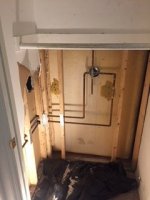Casualfc
New Member
I am in the Northeast and have a garage converted into an apartment that I use occasionally as an office. There's no HVAC, just electric baseboards. There's a full bath. Recently I had a pipe burst and shoot water through a few walls. This was quickly fixed. As I removed the drywall, I followed the supply lines around the wall. Now I'm on hold. I don't intend on ripping all the walls out. My original plan was to use rubber insulation and blanket insulation in the walls for all the supply lines I can get to. Now I'm considering putting in shutoffs on the cold and hot lines where they come into the shower. Before that on the line are a sink and toilet which I can shut off at their own valves.
My question is- should I 1) bother with shutoff valves even through it would only take care of the shower or 2) just insulate pipes and walls or 3) install shutoffs and do the insulation anyway?
Thanks in advance. I've attached a photo of the closet where this is being done, in case it helps.
My question is- should I 1) bother with shutoff valves even through it would only take care of the shower or 2) just insulate pipes and walls or 3) install shutoffs and do the insulation anyway?
Thanks in advance. I've attached a photo of the closet where this is being done, in case it helps.


